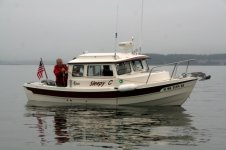hardee
New member
- Joined
- Oct 30, 2006
- Messages
- 12,637
- Reaction score
- 2
- C Dory Year
- 2005
- C Dory Model
- 22 Cruiser
- Hull Identification Number
- Brat # 2202
- Vessel Name
- Sleepy-C
berryst":2js1hlpn said:On big trips or big water I always, always wear a full coastguard float suit. Its not auto inflate. A life preserver around here will save your life, a suit will keep you alive.
"stuff clipped"
In the crowded waters of Puget sound on a sunny day I often don't wear a thing I just keep the float coats handy
Chris
I might beg to differ with the results of wearing a life preserver in the PNW. In our waters, the temps run 45 - 50 degrees most of the year. The life preserver will save your life if someone is within earshot when you hit the water or for about 10 minutes. Otherwise, they are just good for finding the body. Still, that is what I wear -- always.
The suit is the way to go if you are going to be in the water for any length of time over 10 minutes. On another note: Any time someone goes into the water here, a real probability is cold water shock resulting from head and/or face submersion into the cold water, resulting in cardiac shock and possible ventricular fibrilation and sudden death. The likelihood of this increases with age and lower water temps.
Interesting thoughts about going out of an overturned C-Dory. My guess is that the cabin will not be filled with water initially, if the cabin door was closed at capsize, both allowing some time to get oriented, and not initially inflating the auto inflate PFD as well possibly making it hard to get the door open against the water pressure.
Might be a good idea to carry the required (non-inflatable) PFD's in the cockpit instead of the v-birth.
Harvey
SleepyC :moon


